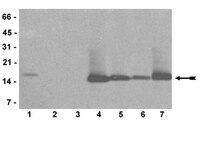Chemical and biological methods to detect post-translational modifications of arginine.
Slade, DJ; Subramanian, V; Fuhrmann, J; Thompson, PR
Biopolymers
101
133-43
2014
Show Abstract
Post-translational modifications (PTMs) of protein embedded arginines are increasingly being recognized as playing an important role in both prokaryotic and eukaryotic biology, and it is now clear that these PTMs modulate a number of cellular processes including DNA binding, gene transcription, protein-protein interactions, immune system activation, and proteolysis. There are currently four known enzymatic PTMs of arginine (i.e., citrullination, methylation, phosphorylation, and ADP-ribosylation), and two non-enzymatic PTMs [i.e., carbonylation, advanced glycation end-products (AGEs)]. Enzymatic modification of arginine is tightly controlled during normal cellular function, and can be drastically altered in response to various second messengers and in different disease states. Non-enzymatic arginine modifications are associated with a loss of metabolite regulation during normal human aging. This abnormally large number of modifications to a single amino acid creates a diverse set of structural perturbations that can lead to altered biological responses. While the biological role of methylation has been the most extensively characterized of the arginine PTMs, recent advances have shown that the once obscure modification known as citrullination is involved in the onset and progression of inflammatory diseases and cancer. This review will highlight the reported arginine PTMs and their methods of detection, with a focus on new chemical methods to detect protein citrullination. | 23576281
 |
Histone H3K4 demethylases are essential in development and differentiation.
Benevolenskaya, Elizaveta V
Biochem. Cell Biol., 85: 435-43 (2007)
2007
Show Abstract
Lysine histone methylation is one of the most robust epigenetic marks and is essential for the regulation of multiple cellular processes. The methylation of Lys4 of histone H3 seems to be of particular significance. It is associated with active regions of the genome, and in Drosophila it is catalyzed by trithorax-group proteins that have become paradigms of developmental regulators at the level of chromatin. Like other histone methylation events, H3K4 methylation was considered irreversible until the identification of a large number of histone demethylases indicated that demethylation events play an important role in histone modification dynamics. However, the described demethylases had no strictly assigned biological functions and the identity of the histone demethylases that would contribute to the epigenetic changes specifying certain biological processes was unknown. Recently, several groups presented evidence that a family of 4 JmjC domain proteins results in the global changes of histone demethylation, and in elegant studies using model organisms, they demonstrated the importance of this family of histone demethylases in cell fate determination. All 4 proteins possess the demethylase activity specific to H3K4 and belong to the poorly described JARID1 protein family. | 17713579
 |














